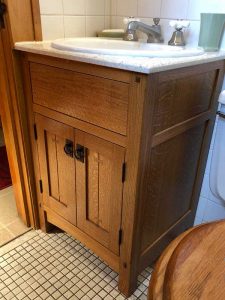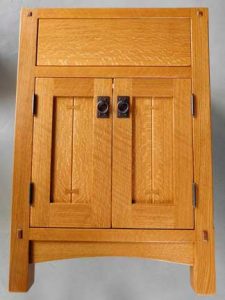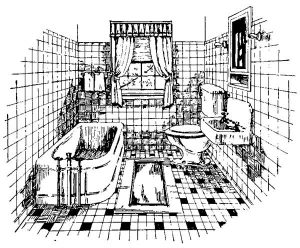Small Home Gazette, Spring 2018
An Arts & Crafts Vanity Project
Our 1926 Arts & Crafts foursquare home has progressed through several common restoration projects: stripping and refinishing crown molding; changing dated wallpaper to period paint colors; removing shag carpet over oak flooring; and more. Our next conundrum—the first floor powder room. The elephant in this tiny room was a 1950s-era vanity installed in one corner. It consisted of a painted plywood box with cheap hardware and a single wood leg supporting the front corner. On with demolition!
Removing the existing vanity was a given, but what should we install in its place? It is likely that there was originally a wall-hung sink. While cabinet-style vanities were common in Victorian bathrooms, during the early century the dominant bathroom design was the “sanitary” style, which featured white subway tile and porcelain fixtures such as a pedestal or wall-hung sink. The now familiar cabinet-style vanity didn’t begin to reappear in bathrooms until around 1940.
Going back to a wall-mount sink would be a faithful nod to authenticity, but there were other practical considerations. First, removal of the old vanity revealed that a long strip of wall tile had been chiseled out to accommodate setting its top into the wall. Repairing damaged tilework is not easy, and with no spare original tiles available, restoration would be virtually impossible. And there was another issue common to older homes—storage. Even in a powder room, there’s a need to stash supplies and cleaning materials.
 In the end, we decided to install a new vanity with Arts & Crafts styling as a compromise. Because of the powder room’s unusual dimensions, a stock vanity wasn’t feasible, so ours became a custom cabinetry project. We began with a sketch of a vanity front with some Arts & Crafts design features we like. By increasing the height of the new vanity by a half inch, we could cleanly hide the missing wall tiles. Being a corner vanity, only two faces would need to be finished.
In the end, we decided to install a new vanity with Arts & Crafts styling as a compromise. Because of the powder room’s unusual dimensions, a stock vanity wasn’t feasible, so ours became a custom cabinetry project. We began with a sketch of a vanity front with some Arts & Crafts design features we like. By increasing the height of the new vanity by a half inch, we could cleanly hide the missing wall tiles. Being a corner vanity, only two faces would need to be finished.
With our concept complete, we contacted Timeless Woodworks in south Minneapolis. The owner, Greg Beam, is committed to Arts & Crafts ideals and is listed in the Twin Cities Bungalow Club Service Provider Directory, published for Bungalow Club members in 2016. He is congenial, thorough and detail-oriented.
Beam helped refine our design with advice about proportions and construction and provided us with a precise CAD (computer-aided design) drawing for final approval. He also brought a selection of quarter-sawn oak stock from Youngblood Lumber Co. to our house. He highlighted the grain and flaking on each piece by applying a light water spray outdoors in the sunlight. We chose pieces with beautiful patterns that would look good side-by-side when assembled.
 We selected door pulls from the Craftsman Hardware Co. in Marceline, Missouri. The wood’s stain color was matched to an oak medicine cabinet we’d already installed in the powder room. Bathrooms are a harsh environment for wood, so Beam used polyurethane varnish. He also inserted adjustable plastic feet in the vanity legs so that the wood wouldn’t come in contact with any water on the floor.
We selected door pulls from the Craftsman Hardware Co. in Marceline, Missouri. The wood’s stain color was matched to an oak medicine cabinet we’d already installed in the powder room. Bathrooms are a harsh environment for wood, so Beam used polyurethane varnish. He also inserted adjustable plastic feet in the vanity legs so that the wood wouldn’t come in contact with any water on the floor.
To complete the vanity, we chose a small oval sink from Kohler and a complementary Corian vanity top. We always enjoy the bungalow period look of cross-handle faucets, so we opted for a Kingston Brass “Metropolitan” style faucet in satin nickel.
Beam delivered the completed vanity, and we went ahead with final installation. The legs were adjusted for level and height, and the vanity was mounted in the room’s corner with screws.
We’re now celebrating another bit of Arts & Crafts home renewal!
Resources
The Bathroom, the Kitchen, and the Aesthetics of Waste, by Ellen Lupton and J. Abbott Miller, 1997. Out of print; used copies available online.
Craftsmen Hardware Co.
Marceline, Mo.
craftsmenhardware.com
Timeless Woodworks
Minneapolis
timelesswoodworks.com
Youngblood Lumber Co.
Minneapolis
youngbloodlumber.com












